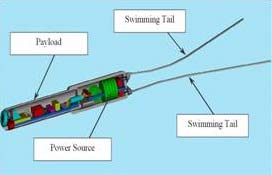Miniature Robot to Power Through the Spine

In the 1966 film "Fantastic Voyage," a full-size underwater vehicle was shrunk to microscopic size and injected into the blood vessels of a person. Now, a team headed by Dr. Moshe Shoham of Haifa's Technion has created a novel propulsion system for a miniature robot to travel through the spinal canal, powering through cerebrospinal fluid. Dr. Shoham is also the primary developer of the SpineAssist robot to aid surgeons in performing delicate spinal procedures (see SpineAssist Robot Has Got Your Back).
The requirements for a robot that moves through body cavities are strict; it must be small enough to move through the body and it must have a propulsion system that is flexible enough to work. Devices like the PillCam, a pill-shaped camera that is swallowed to picture the complete digestive tract, are moved along by the body's own peristalsis, and do not need their own propulsion system.
"The first location we're targeting is the spinal canal—which means the device will travel through the cerebral spinal fluid (CSS) which is clear and similar to water. It doesn't flow too fast, but it needs propulsion," said Dr. Shoham. "Now we have the propulsion system, but we still don't have the actual payload—whether it's a camera from images, or a subsystem which would take a biopsy—that's still in the development stage."
The robot would in essence be a free-swimming endoscope; a robot with two actuators—swimming tails—that will have a camera in the head to broadcast images to the physician outside (see diagram).
"This is a unique swimming mechanism that is adapted to tiny sizes and, with very low power consumption", the Technion researchers explain. "In the future, we hope that the robot will also be able to perform biopsies and release medications for local treatment."
Shoham estimates that it will take several more years to complete the design of the robot's payload and to further miniaturize the design. He remarks:
"I believe that in the future there will be micro-robots that will be permanently implanted in our bodies and will be able to navigate to problematic points. This is a step up for micro-penetration into the human body."
Interested in medical robots?
- InTouch Companion: Medical Rounding Robot InTouch Health is now leasing a remote-controlled telepresence robot called The Companion to hospitals and nursing homes nationwide.
- Vecna BEAR Battlefield Extraction And Retrieval Robot Interesting new robot design could be useful for battlefield medical care and other military uses.
- Trauma Pod Battlefield Medical Treatment System DARPA has awarded a $12 million contract to develop an automated medical treatment system that can receive, assess and stabilize wounded soldiers immediately following injury.
Found this one on medGadget.
(This Science Fiction in the News story used with permission from Technovelgy.com —where science meets fiction.)
Sign up for the Live Science daily newsletter now
Get the world’s most fascinating discoveries delivered straight to your inbox.









